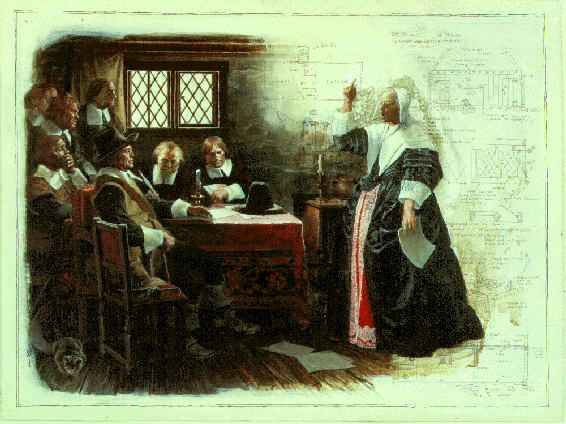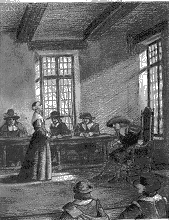

Accompanied by two brothers and a sister, Margaret Brent arrived in St. Mary's City on November 22, 1638. She proceeded to claim a land grant, and engaged in numerous business ventures, trading in tobacco, indentured servants, and land. She appeared in court to sue for debts and to protect her interests, and often acted for her brothers as well. Margaret Brent was named with Governor Leonard Calvert as joint guardian for Mary Kittamaquund, daughter of the chief of the Piscataways. Ten years after her arrival, Margaret Brent was prominent as a businesswoman and landowner.
Existence in 17th-century Maryland was precarious. Threatened by disease, life was hard and often short. Under such conditions, some women were forced to step out of the sheltered sphere they had inhabited back in England. Margaret Brent was not the only woman to claim land in her own right or to pursue her own interests in court. However, she chose to do so; she was not forced. Her continuing unmarried state was unusual in a settlement where the male/female ratio was about six to one.
Born around 1601, Margaret Brent was approximately thirty-seven years old when she arrived in Maryland. Little is known about the first half of her life. She was one of thirteen children born to Richard and Elizabeth Brent. The Brents were landed Catholic gentry living in Gloucestershire. Daughters of such families usually lived quietly at home under the domination of their fathers until they married, at which time control of their lives and their fortunes was transferred to their husbands. In light of her later life, it is hard to imagine Margaret Brent indulging in needlework and other maidenly pastimes for thirty-seven years. She seems to have had some education. Her decision to emigrate to Maryland was not so unique; what was unusual was her coming as head of her own household and not as an appendage of her brothers. Her brothers emigrated to seek opportunities in business and public affairs not available to them in England as Catholics and younger sons; Margaret may have emigrated to escape the inherent constraints of her life in England.
Fifteen years after the first settlers arrived, the Maryland settlement faced a severe crisis. In 1645, the civil war raging in England between Charles I and Parliament spilled over into Maryland. Richard Ingle, a Protestant and a partisan of the English Parliament, invaded St. Mary's City, destroyed the property of Catholic settlers, and took the Jesuit priests and Margaret's brother Giles back to England in chains. Governor Leonard Calvert and other settlers fled to Virginia, and the population of the colony dropped drastically. Late in 1646, the Governor returned with soldiers to reestablish Calvert control. However, Governor Leonard Calvert died in 1647 with his own and Maryland's affairs still in turmoil. From his deathbed, exhorting her to "Take all and pay all," he appointed Margaret Brent his executor, a testimony to his faith in her abilities.
Margaret's decisive actions in such troubled times ensured the survival of the settlement. The most pressing problem was paying Leonard Calvert's soldiers, who were on the verge of a mutiny. Margaret averted that disaster by having the assembly transfer to her Leonard Calvert's power of attorney for his brother Lord Baltimore. Because Leonard Calvert's estate was not sufficient, she sold some of Lord Baltimore's cattle to pay the soldiers. Her most famous action, requesting two votes in the assembly, occurred while she was trying to resolve the Calvert affairs.
Ultimately, Margaret's actions in averting disaster were commended by the assembly to Lord Baltimore, who could not see beyond the loss of his cattle. The Brents never regained his favor and relocated to Virginia by 1651, where Margaret died around 1671.

Margaret Brent remains
an enigma. Her life was filled with actions remarkable and unusual for
a woman of the 17th century. Documents record at least a part of what she
did; we can only conjecture why, just as we can only imagine what she looked
like. No contemporary images of her survive.
Source: Ann Baker.
Prepared for the use of Government House. ©Maryland
State Archives, 1997 (rev. 1998)